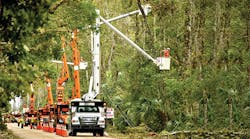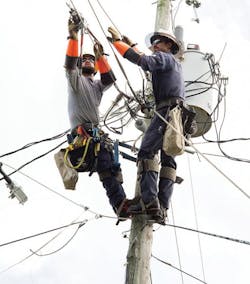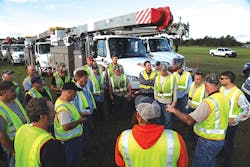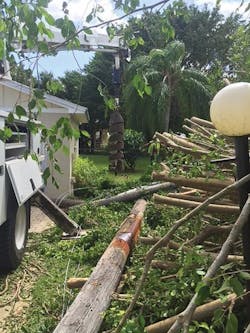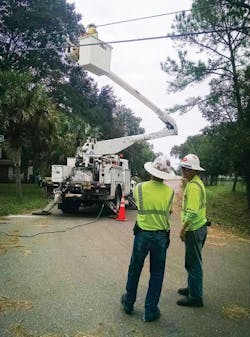Over the last decade, Florida Power & Light (FPL) has invested more than $2 billion to harden its system and build a smarter and stronger energy grid. In October 2016, Mother Nature tested this system with Hurricane Matthew, a Category 3 hurricane that caused 1.2 million service interruptions and impacted major portions of FPL’s service area as it hugged Florida’s east coast.
FPL considered its prompt response to the storm to be the most effective in its history, both in terms of pre-positioning resources and using a large workforce to restore service quickly to affected customers. By strengthening its electrical system, upgrading power lines and poles, and leveraging smart grid technology, FPL restored 99% of its customers in less than two full days after Hurricane Matthew exited the service area. Crews were able to restore service to all customers who could receive service within only four days.
Smart grid automated switches on the FPL system prevented about 118,000 customer interruptions. Strengthened distribution main power lines, which were designed to withstand more severe weather conditions, performed 30% better than non-strengthened main power lines. In addition, no FPL transmission poles or hardened main power line poles failed because of Hurricane Matthew’s high winds.
Handling Tree-Caused Outages
Unlike many hurricanes that weaken when they hit land, Hurricane Matthew passed along the east coast of Florida as it moved north. Sustained winds reaching 80 mph and gusts as high as 107 mph blew debris and, in some cases, toppled trees onto power lines.
High winds, debris, fallen trees and flooding affected customers across major portions of FPL’s service area. Some of the hardest-hit areas were six counties in central and north Florida. In these locations, significant damage to lateral feeders required FPL, in some cases, to rebuild its electric infrastructure from the ground up.
Most of the damage was a result of trees and debris falling over power lines and poles, as many areas had not experienced hurricane-force winds for more than a decade. Restoration efforts in these areas required extensive manual labor, such as removing and clearing trees, installing new poles and rehanging power lines.
Restoring Power
FPL’s crews worked around the clock to restore service to customers safely and as quickly as possible. At the height of restoration, FPL’s workforce numbered about 14,600, including its own employees, contractors and partner utilities across the country. FPL and its partner utilities and contractors remained laser-focused throughout restoration. Resources from more than 200 utilities and external companies, including electric utilities, line contractors, vegetation clearing crews and logistics vendors from more than 26 states, traveled to Florida to help with the restoration effort. Partner utilities traveled from as far as west as Texas and as far north as Massachusetts to assist in FPL’s restoration efforts.
On the Move
Following the hurricane, several power line contractors also dispatched crews to help impacted utilities to repair damaged infrastructure and restore power. For example, MYR Group Inc. sent crews from three subsidiaries with locations in the eastern United States and Texas — The L.E. Myers Co., Harlan Electric Co. and Great Southwestern Construction Inc. L.E. Myers sent crews from Florida, Virginia and Tennessee, Harlan Electric mobilized crews from Pennsylvania, and Great Southwestern called upon its crews from Texas.
Several utility companies dispatched lineworkers, supervisors, forestry workers, damage assessors and support personnel to FPL’s processing site in Lake City, Florida, to assist with anticipated storm damage. FPL then directed the crews to the hardest-hit areas, and some crews were pre-staged in order to begin restoration efforts immediately following the storm.
“In addition to our continued investments in the grid, the energy of our team was also critical to help get the lights back on quickly for our customers when they needed us the most,” says Manny Miranda, senior vice president of power delivery for FPL. “That includes the community partners, utilities and contractors we worked with to restore, rebuild and recover after the hurricane.”
After the storm passed and restoration began, the weather conditions were favorable and didn’t present any significant challenges to the crews, says Kevin Gribbon, district manager for L.E. Myers. For about seven days, the crews worked 16- to 18-hour days with an 8-hour rest period for FPL in Florida. Crews responding for Duke Energy worked four 16- to 18-hour days in Florida before being directed to help with restoration efforts for a week in North Carolina.
During the restoration, the crews performed work along coastal waterways in remote rear-lot locations. As a result, obtaining access for equipment and material was challenging and time-consuming, Gribbon says. Despite this, MYR Group crews were pleased with the quick response and support provided by their fleet department. Kevin Camp, regional safety manager for MYR Group, mentioned that fleet personnel were proactive and responsive in ensuring the right equipment was provided when required and that fleet support was on site 100% of the time.
On the first day, the lineworkers started in the West Palm Beach, Florida, area, and then they gradually followed the path of the storm north. Over their weeklong engagement, they had traveled 150 miles north to Daytona Beach, Florida, to participate in restoration work. Because the linemen were constantly on the move, it was challenging for the companies to provide new lodging and meals for the crews.
Staging Crews
Before and during Hurricane Matthew, FPL deployed its largest pre-storm staging effort in the company’s history. The company pre-staged resources in Miami-Dade County in advance of the storm, and after the storm passed, staging sites were set up along the east coast of the state in Palm Beach, Brevard, Volusia, Flagler, St. Johns and Putnam counties.
Staging sites are critical “hubs” that FPL uses to move thousands of utility workers and equipment closer to storm damage. The “mini cities” allow FPL to stock thousands of miles of wire, transformers, poles and equipment; fuel hundreds of trucks daily; book lodging for crews; and serve thousands of meals to keep service restoration efforts going 24/7.
FPL also deployed three community response teams to areas with concentrated outages to provide charging stations for electronic devices and free Wi-Fi to the immediate community. FPL also staged one of its Mobile Command Centers in Brevard County to help coordinate resources.
Staying Safe
FPL safely onboarded thousands of crews as they arrived to ensure they stayed safe while working in the field and to familiarize them with its equipment as well as the potential challenges in the area. Both MYR Group management and crews were impressed with this safety orientation, Camp says.
“They did an excellent job of ensuring that anyone working on their system was well-oriented when it came to both technical, procedural and communicative aspects of the work. The orientation was extremely thorough,” Camp says.
For the storm restoration, MYR Group deployed five safety engineers with the crews. These individuals spent 100% of their time in the field assisting and supporting crews. Management also made field visits to lend support and address crews’ needs. Also, MYR Group held a daily safety call each day across the three responding districts to discuss safety concerns, specific crew locations and restoration progress. Then the crew leaders disseminated this information to the crews.
With so many crews working on adjacent feeders and circuits, MYR Group’s linemen had to maintain a heightened awareness during the storm response. For example, during the pre-job briefs, the crews focused on the need for testing and grounding because of the potential for accidental energization by others.
“It was important that we knew who was working near us, and that they knew we were working near them,” Gribbon says.
Linemen worked directly with FPL and Duke Energy support personnel to get the power turned back on safely and efficiently. With so many utility and contracted crews deployed on the event, Gribbon says the crews did a great job of ensuring they communicated with the respective owner’s representative to ensure a steady work flow.
“With any major storm event, confusion and downtime is unavoidable,” Gribbon says. “It is our job as responsible contractors to recognize this and assist utilities in every way possible.”
Gaining Recognition
After the MYR Group crews wrapped up their restoration work, they were satisfied and proud to turn the lights back on, Gribbon says. “They understand that as the duration of the restoration efforts increase so will the tempers of people who have been without power,” Gribbon says.
Some of the customers, however, made sure to thank the line crews for a job well done. “A group of neighbors left hand-written thank you notes on all 10 trucks one night,” Gribbon says. “These crews kept the notes on their dashboards.”
Crews from FirstEnergy Corp., which dispatched 250 linemen and 100 supervisors, forestry workers, damage assessors and support personnel from multiple utility companies, were also recognized for their hard work. One 92-year-old resident of Holly Hill, Florida, insisted that she get her picture taken with Jersey Central Power & Light personnel after they turned her power back on. Also, a Daytona Beach, Florida, resident thanked the crews from Pennsylvania Electric with a homemade sign posted in a window that said “T.Y. Penelec.”
John Huber, FirstEnergy’s director of emergency preparedness, says the crews were all committed to working safely during the storm restoration. “The customers we restored were very appreciative of our efforts and impressed with how well our employees work under difficult conditions,” Huber says.
Reflecting Upon the Storm
During the weeks after Hurricane Matthew, FPL continued rebuilding and making enhancements to its infrastructure to fully return the system to its pre-storm conditions.
Going forward, FPL plans to continue to incorporate the lessons learned from Hurricane Matthew to continue to enhance its system and make its processes and procedures even more efficient and effective. Through a proactive approach, FPL was able to strengthen its system so it could withstand Mother Nature’s wrath. At the same time, the utility was able to call upon other utilities and power line contractors to restore power swiftly in the wake of major storms.
Sidebar: By the Numbers
During Hurricane Matthew, Florida Power & Light was able to minimize the number of
interruptions and speed restoration because of the significant investments it has made to its electric system over the last decade, which include the following measures:
- Strengthened more than 600 main power lines, including those that serve more than 700 critical community facilities.
- Cleared vegetation from more than 135,000 miles of power lines.
- Completed 1.4 million power pole inspections, and upgraded or replaced the poles that no longer met FPL’s standards for strength.
- Installed more than 4.8 million smart meters and 36,000 intelligent devices to help predict, reduce and prevent power outages and restore power more quickly if outages occur.
- Installed real-time flood monitors at 223 substations that are susceptible to flooding. In addition, FPL installed additional water-intrusion protection measures, including sump pumps, flood-resistant doors, sealed windows and other openings in substation vaults.
Sidebar: Ohio Edison Crews Help Roadside Victims
Utilities and contractors not only lent a helping hand in the storm-stricken zones, but also on the way to the restoration sites. For example, just after being released by Florida Power & Light Co., Ohio Edison’s crews hit the road for Florence, South Carolina, to help Duke Energy. On the way, a serious multi-vehicle accident occurred right in front of them. Since they were trained in emergency response, the crews sprang into action by activating the strobe lights and flashers on their vehicles and pulling over to the side of the road.
The linemen then put on their traffic vests and pulled necessary supplies like fire extinguishers and First Aid/blood born pathogen kits out of their trucks to help the injured motorists. The crews pulled the victims out of the cars, extinguished a vehicular fire and exerted pressure on a victim’s laceration until paramedics arrived on the scene.
Dan Janosik, supervisor of regional operations for Ohio Edison, says he was proud of the professionalism and compassion that his crews showed in responding to the accident. “They immediately tapped into their company training and helped to secure the scene, address hazards and comfort motorists,” he says. “After spending a week restoring service, they were still willing to help whenever and wherever assistance is needed.”
